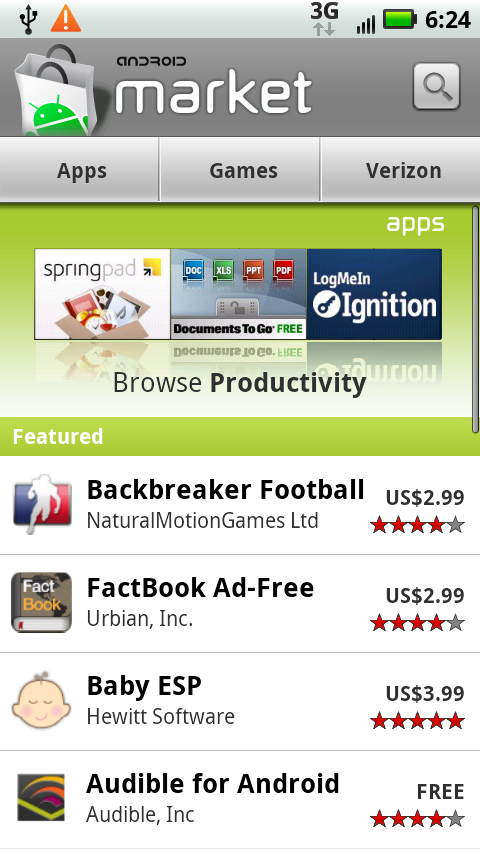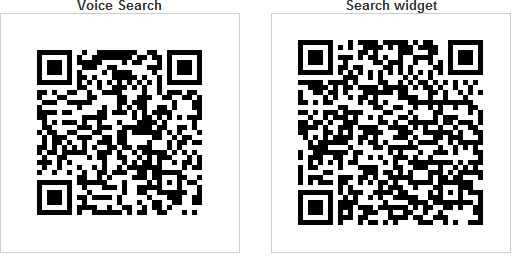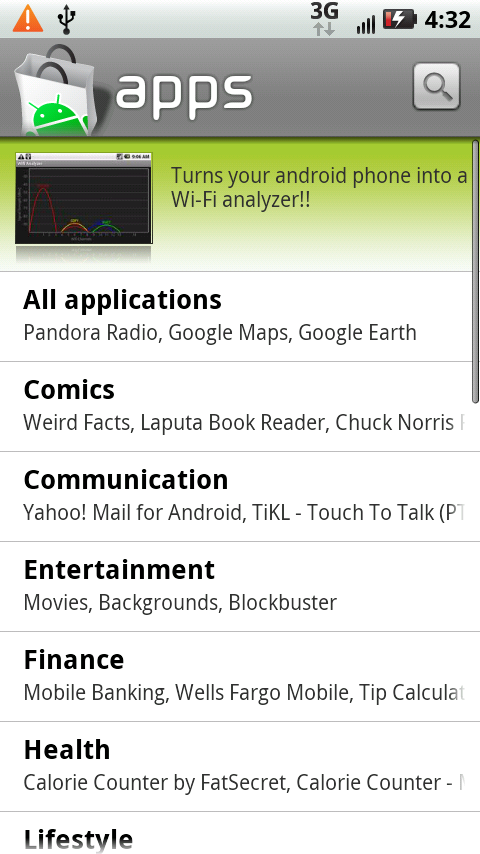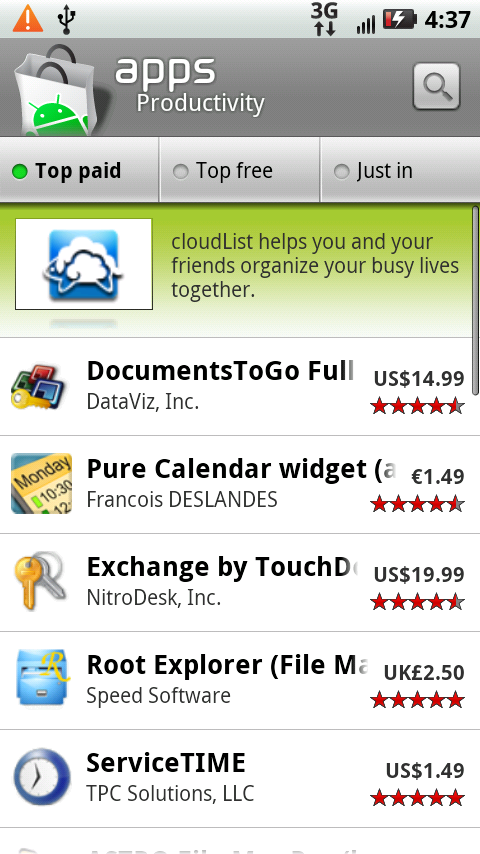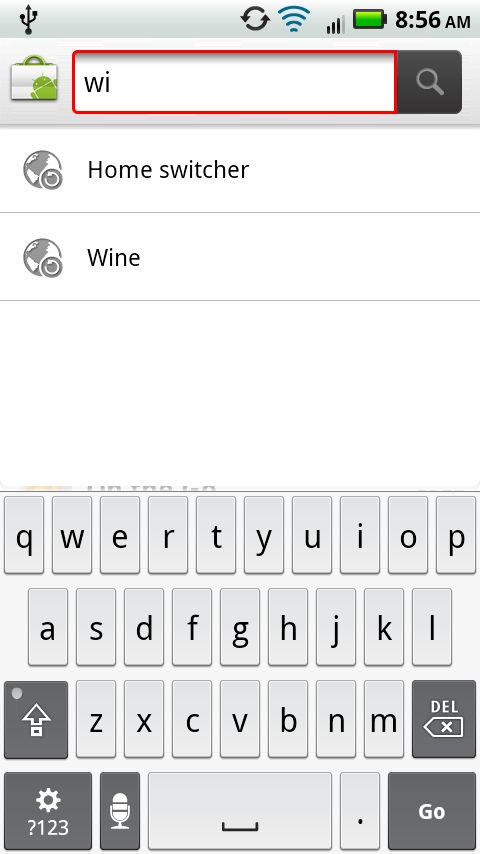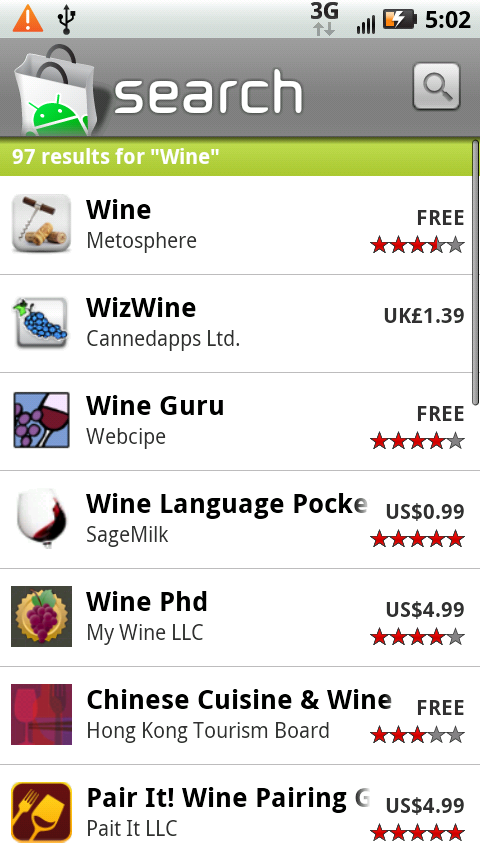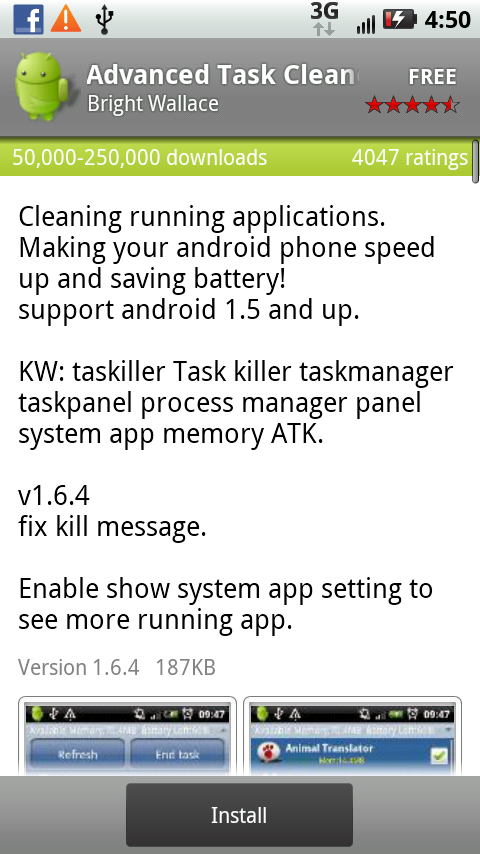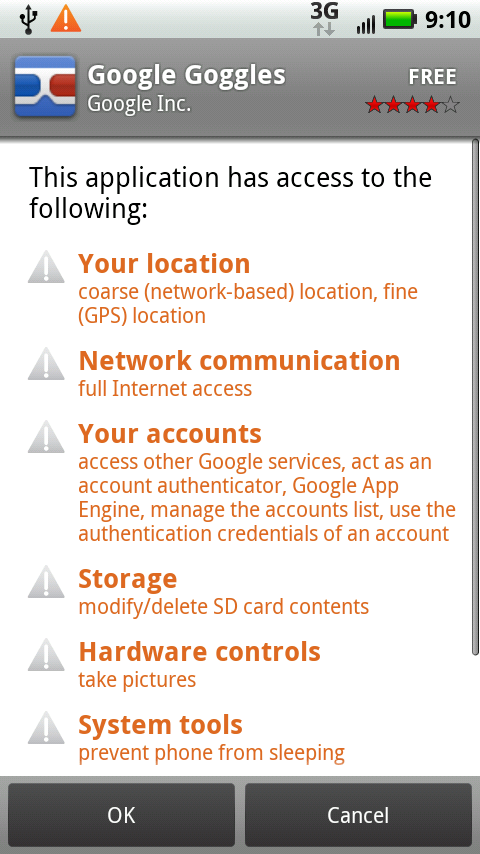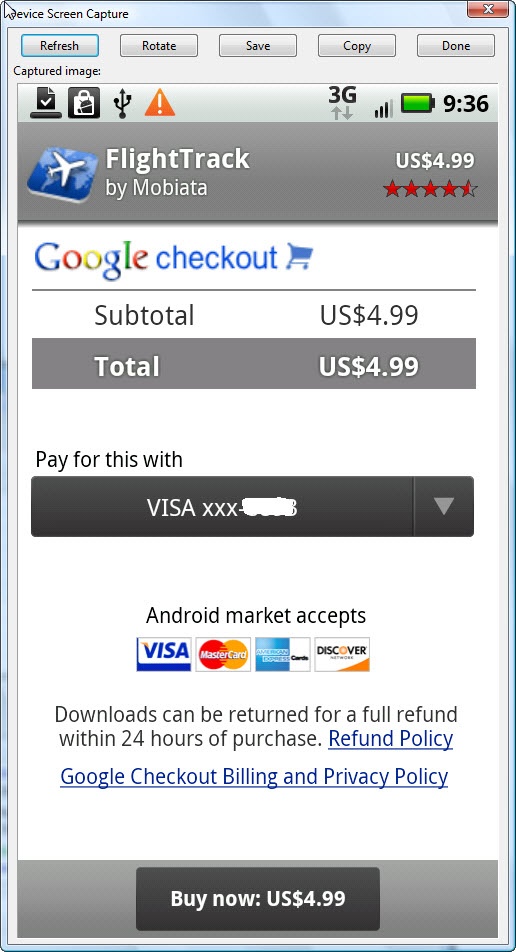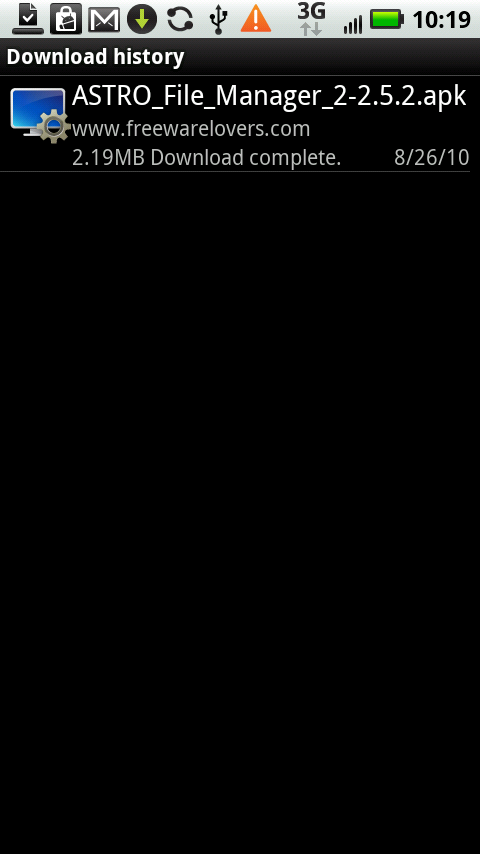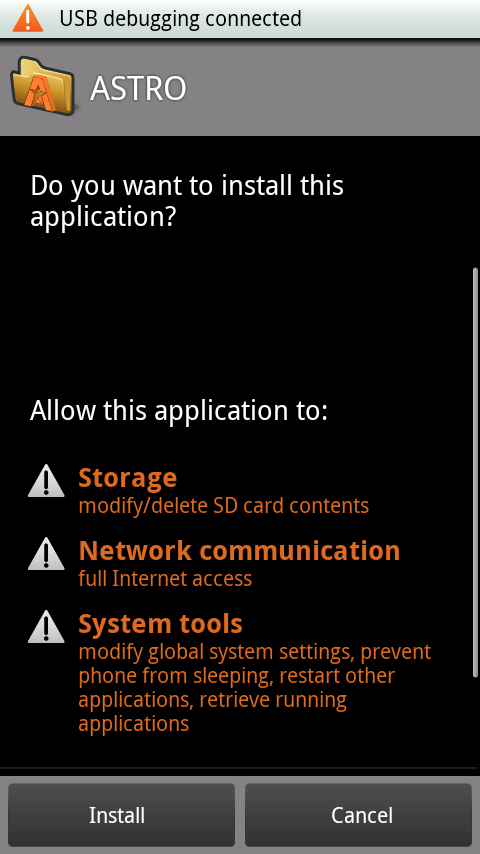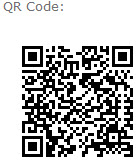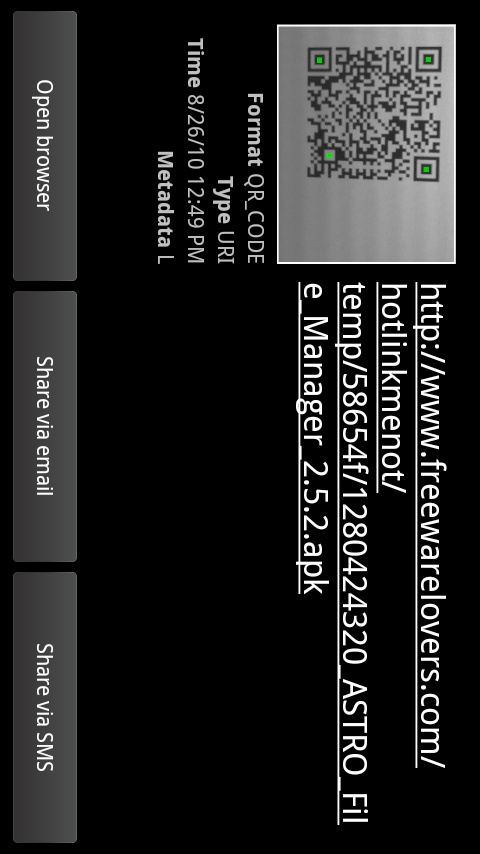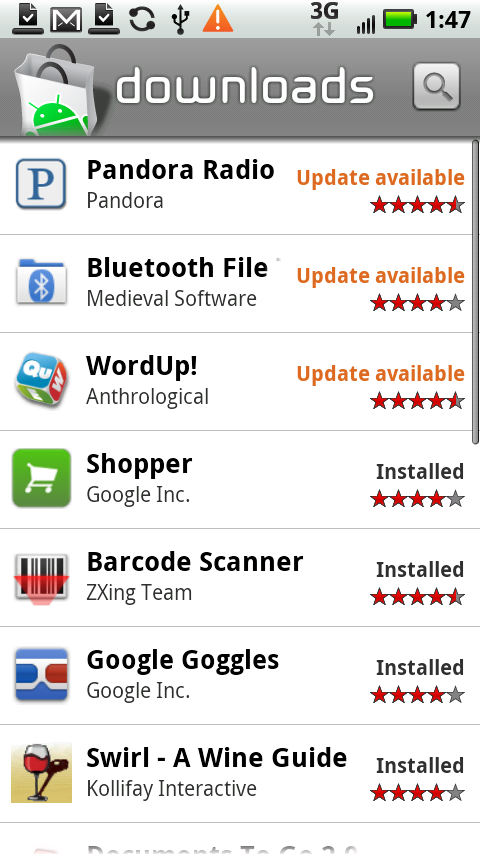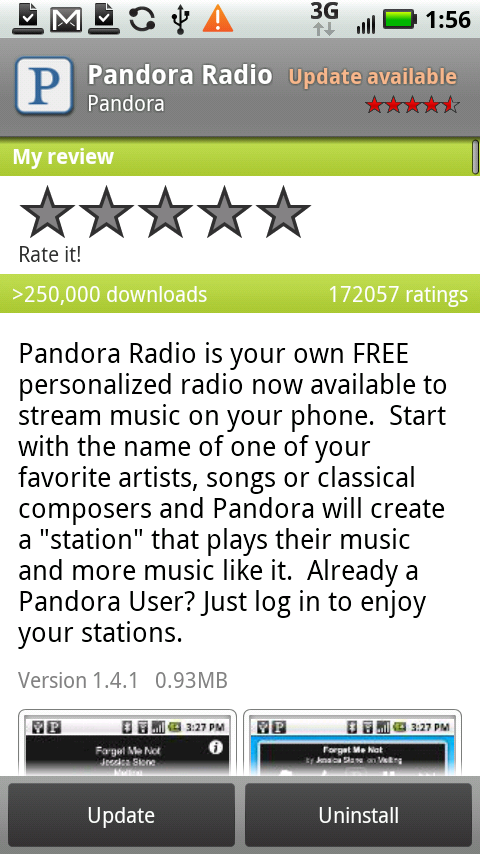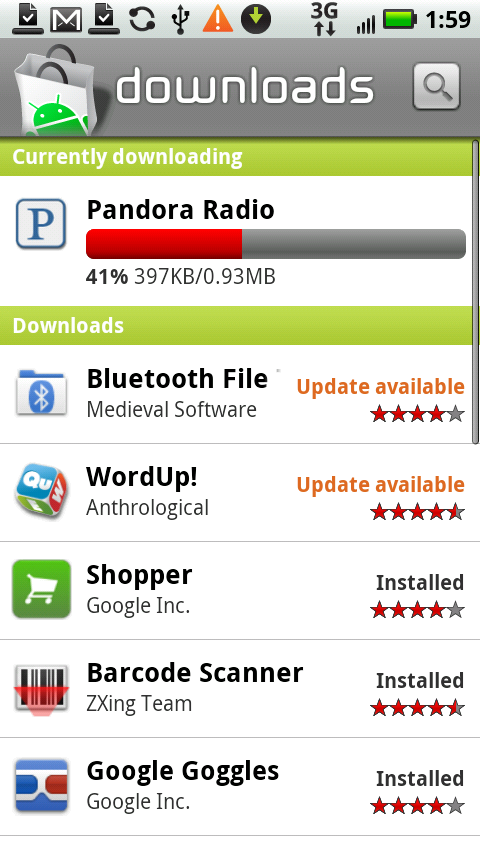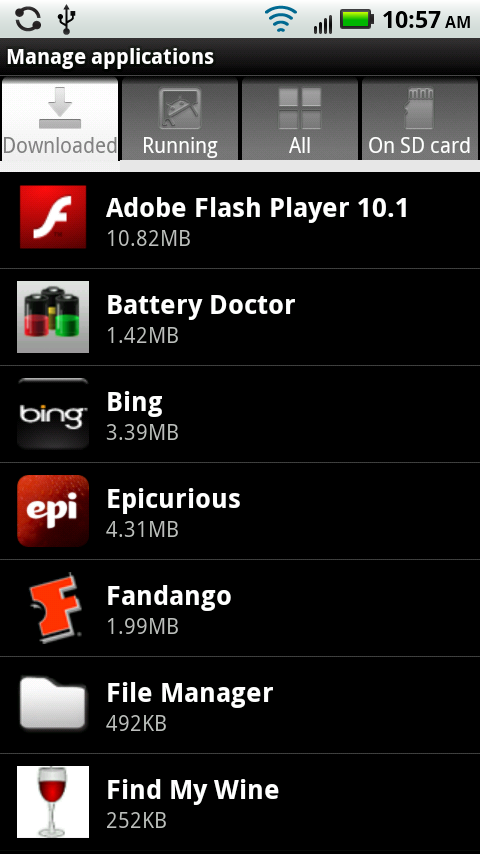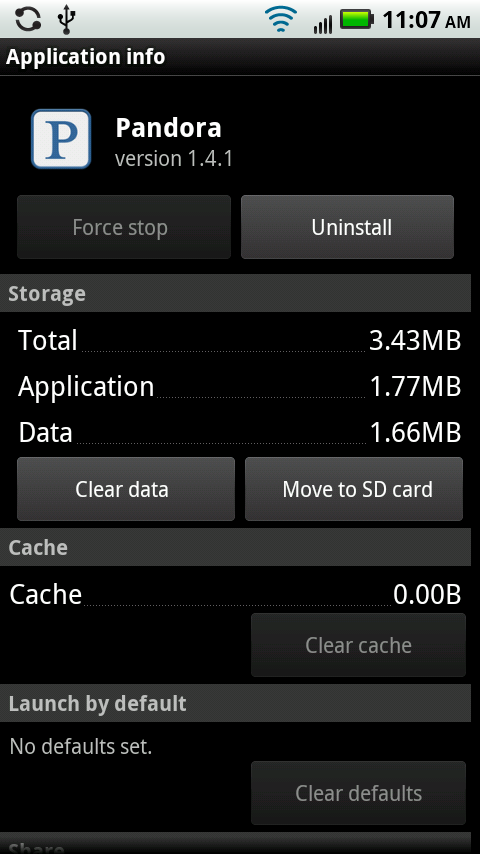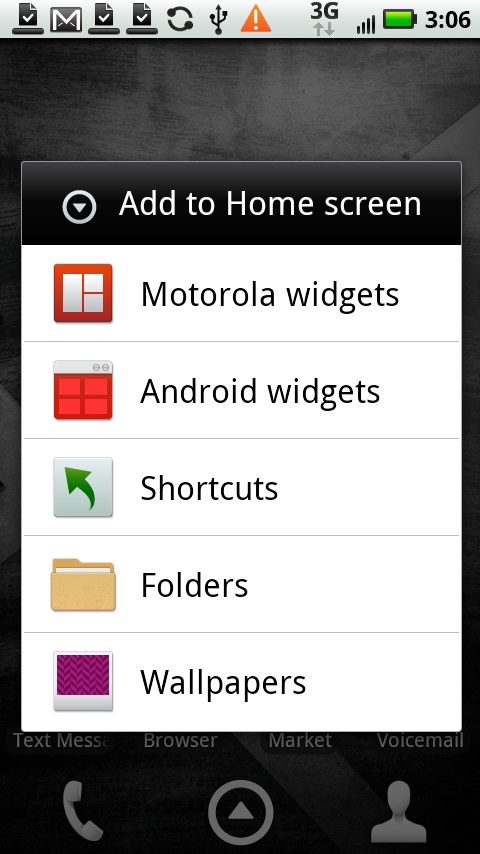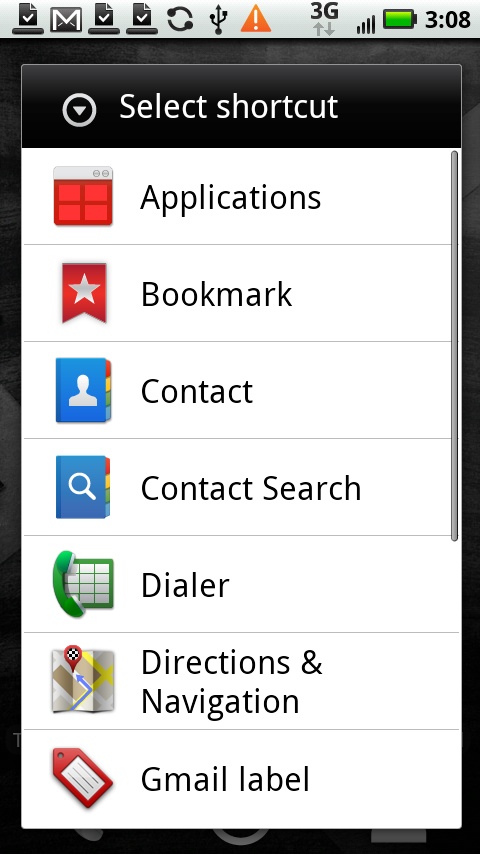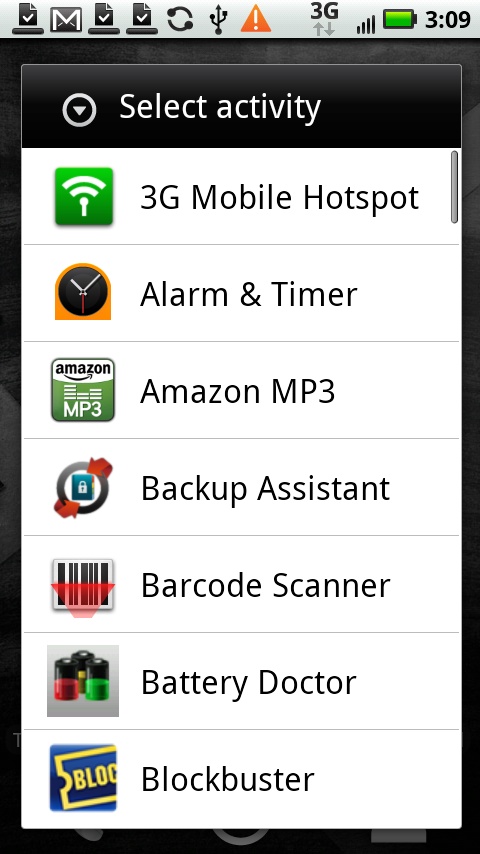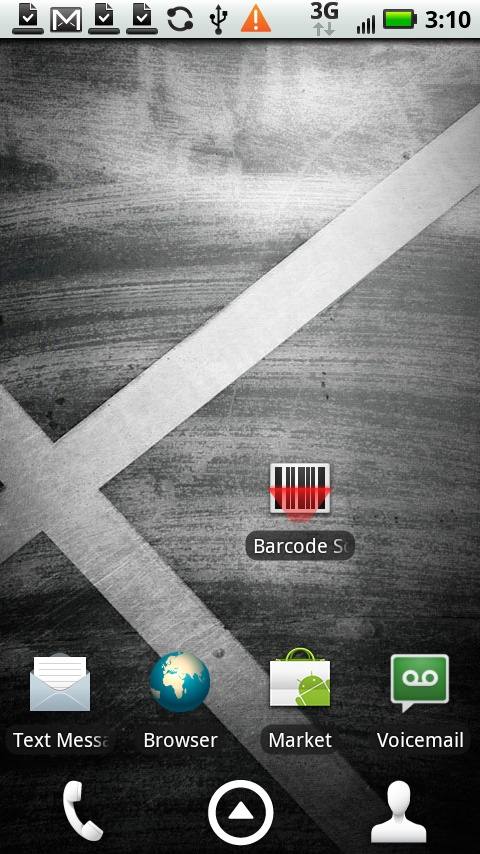Chapter 11. Downloading and Using Apps
Why do you have the Droid 2 rather than a plain-Jane cellphone? If you’re like most people, it’s for the apps, which let you handle email, Google Maps, Contacts, and your calendar, as well as countless unexpected and remarkable things like using your phone as a bar code reader or a guitar tuner.
The Droid 2 features plenty of useful built-in apps, which are covered throughout this book. One of its great features, though, is its ability is to let you download and use new apps as well—apps that do just about everything under the sun (and sometimes a few things that seem beyond the range of the solar system).
In this chapter, you’ll find out how to get and use those apps, as well as how to uninstall and troubleshoot them. It’ll also show you how to use a few of the more amazing Android apps available online.
The Droid 2’s Free and Easy Approach to Apps
The Droid 2, like all Android phones, takes a different approach to the use of apps than some other phones: There’s absolutely no limitation on what you can download. Android’s developer, Google, doesn’t step in to say what you can and can’t download, and neither does the Droid 2’s manufacturer, Motorola, or its carrier, Verizon.
That means you’re free to choose from tens of thousands of apps, with thousands more being written every month. There are apps for tracking expenses, chatting with people, playing games, using social networks like Twitter, finding new friends, making your Droid 2 work better, tuning your guitar, viewing maps of the night sky, and much more.
Tip
Some Android apps cost money, but many more are free. So whenever you find a for-pay app, do a bit of searching to see if you can find a free one that does the same thing.
These apps tie into the Droid 2’s unique hardware and software. One even automatically detects potholes as you drive, using the Droid 2’s various sensors to measure sudden movements. The app then uses the Droid 2’s positioning software to locate exactly where the pothole is, and creates a text file with all the relevant information so you can send it to your local Department of Public Works. (Unfortunately, no app has yet been developed that will get your local Department of Public Works to actually fix the pothole.)
Apps and Multitasking
The Droid 2 is great at multitasking—running more than one app at a time. For example, you can browse the Web while you listen to music, receive email, and have Facebook updates delivered to you, all without breaking a sweat.
You usually don’t know that Android is multitasking, though, because unlike in operating systems like Windows or Mac OS X, you can’t see all running apps simultaneously or switch between them with just a keystroke (like Alt+Tab in Windows). Instead, you tap the app’s icon.
When you’re in an app and want to do something else on the Droid 2, you typically press the Home key. From there, you can tap to run an app such as the web browser, or open the Application Tray to run more apps. When you do that, though, that first app is still running in the background. If it’s a music-playing app or a radio app, it keeps playing until you close it. With many other apps, though, at some point the Droid 2 will notice that you haven’t used it in a while and close it down. You won’t even notice that the Droid 2 has closed it.
Note
You can find apps called task killers that claim to speed up your Droid 2 by automatically closing apps when they’re no longer needed, or by letting you manually close those apps. Most everyone agrees that the apps are superfluous—the Android operating system does an excellent job of closing apps when they’re no longer needed. Not only that, but many task killers won’t run with the latest version of the Android operating system, version 2.2 or greater.
There is a way to make sure that you close an app when you switch away from it, though. Rather than pressing the Home key to run another app, press the Menu key and look for a menu choice that closes the app. Not all apps offer this choice, but that’s okay; the Droid 2 will close the app when it’s no longer needed. If for some reason, though, you want to close an app and it doesn’t have a menu choice for that, you can still do it—see Managing, Sharing, and Uninstalling Apps.
Where to Get Apps
The Droid 2 offers you not just one, not just two, but three different ways to download and install apps:
Market. Here’s the primary way that most people download and find apps. It’s right on your Home screen. Tap the Market button and it launches. From here you can search for apps, find information about apps, and pay for them.
The Web. You can download and install apps from websites. Visit the site on your Droid 2 browser, and download from there.
Using a bar code scanner. Of all the amazing tricks the Droid 2 can do, this one may just be the coolest. A free app gives the Droid 2 the ability to scan bar codes and QR codes. (QR codes are a special kind of bar code used by smartphones, cameras, and other devices.) After you’ve installed this app, you can use your Droid 2 to scan a QR code to download other apps. When you’re browsing the Web with your PC or Mac, and you come across a bar code for downloading, just point your Droid 2 at it, click a button, and the magic begins. The phone grabs and installs the software from the website. For more on bar code scanning, see Downloading and Using a Bar Code Scanner.
Using Market
Tap the Market icon, and you get sent to the Android Market, which has tens of thousands of apps you can download, with more added every month. The apps are either free or very low cost—typically under $4, although some business-related apps can cost up to $30.
Major library divisions are located across the top—Apps, Games, and Verizon. The Apps area has all apps except for games; Games has, as the name implies, only Games; and Verizon has a number of Verizon-specific (and a number of non–Verizon specific) apps, like ones for using the Verizon V CAST service and managing your Verizon Wireless account.
A changing category list is just beneath the library divisions, with topics like Arcade & Action, News & Weather, and so on. The category changes every few seconds. Tap it to see a list of apps in that category.
A featured list is at the bottom. It lists the names of apps, the developer of the apps, and what you’ll have to pay for them, if anything. Tap any to get more information about it.
At the very top of the screen, at the upper right, is a search button. Tap it to search for an app.
Browsing by Library Divisions and Categories
Tap one of the major library divisions across the top of the Market—Apps, Games, or Verizon—and you come to a list of categories in that major division. So, for example, in Apps you’ll find many categories, including Comics, Communications, Finance, Health, Sports, and more.
Tap any category, and you come to a list of all the apps in that category. Each listing shows the name of the app, its maker, its price, and an average user rating.
Near the top of the screen you see “Top paid”, “Top free”, and “Just in” buttons. Tap any to see the list reordered according to what you tapped.
Searching the Market for Apps
Browsing is well and good when you’ve got the time and want to scroll leisurely through lists looking for an app. But often you’re on a mission: You know the type of app you want, and you want to find it fast.
In that case, you want to search. You can search by the type of app, the name of the program, or the name of the software company that created it. Tap the Search button, and a keyboard and a search box appear. As you type letters, you see apps that match those letters, regardless of where the letters are found in the app name—for example, type “Wi” and the search term “Task Switcher” appears on the list, as does the term “Wine.” As you type more letters, the results list shortens, since it shows you only letters or terms that match your search.
Complete typing your search or select a term from the list, and you see a list of programs that match what you’re looking for.
Getting Info About an App
No matter what type of list you look through—whether as a result of a search or by browsing—you’ll eventually want to get more details about an app and possibly download it. In that case, tap the name of the app, and you come to a page with a great deal of information about it, including the number of downloads, the total number of ratings on which the star rating is based, the price, a description of the app, screenshots, and individual user reviews.
Tip
Be careful when using the star ratings as a guide to download and pay for an app. In some instances that star rating may be based on just a rating or two. Any star rating based on a few ratings may not be particularly accurate, especially because the ratings may come from the developer and the developer’s friends. If there are a dozen or more user ratings, they’re more trustworthy. So read the actual reviews, and see how many ratings each app has gotten.
Scroll down toward the bottom of the page, and you come to a particularly useful section that’s often overlooked—information about the developer. It lists other apps the developer has written, links to the developer’s home page, and lets you send email to the developer.
Downloading and Installing Apps
Let’s say you’ve read all about an app, and you’ve decided to take the plunge. You’re ready to download. What’s next? Depending on whether the app is free or paid, you do things slightly differently.
If the app is free, you see an Install button at the bottom of the screen. Tap it. A screen appears, telling you what kind of information and features the application has access to, such as your location, your Droid 2’s storage, and so on. Typically, the application needs this kind of access—a GPS app can’t do its job without access to your phone’s GPS features, after all. Still, it’s a good idea to take a look, and if you’re concerned about anything, don’t download.
Next, click OK. The app immediately starts downloading in the background. A small green arrow appears in the Notification bar, showing you that the application is downloading. While the download goes on, you can use your phone in any way you want; the download won’t interfere. Soon a checkbox appears, indicating that the download is complete.
Pull down the Notification bar, and you see a notification that the app has downloaded. Tap the notification to run the app. You can also run the app by heading to the Application Tray and tapping the icon there.
If the app is a for-pay one, you need a Google Checkout account, so set one up ahead of time on the Web at https://checkout.google.com. It’s simple and free.
With that done, you can buy the app. At the bottom of the app screen, instead of an Install button, a Buy button appears. Tap it. As when you’re downloading a free app, a screen tells you what kind of features and information the app will use. Tap OK. Now it’s time to pay. On the next screen, you see the payment details, including how much the app costs, and which credit card in Google Checkout you’re using to pay. (If you want to use a different credit card than the one showing up on the screen, tap the down arrow next to the credit card. You’ll be able to pay with a different card in your Google Checkout account, or pay with a new one.)
Tap the “Buy now” button at the bottom of the screen, and the download proceeds in the exact same way as for free ones.
Note
When you install an app, it goes to your Droid 2’s main memory. However, if you’re running out of room there, or for some other reason want the app to run from your SD card, there’s a way to move the app from the Droid 2’s main memory to the SD card. For details, see Using the Droid 2 Files Application.
Downloading from the Web
You’re not limited to getting apps from the Android Market—you can download them from the Web as well. You can either visit the app developer’s website to download the app, or instead head to one of the many web libraries that house and rate hundreds or thousands of apps.
Note
Be aware that when you install apps from the Web, they don’t go through the same kind of vetting procedure that they do in the Android Market. So be careful about what you download. It’s a good idea to download apps only from well-known developers or well-known, trusted download libraries.
Downloading from the Web takes a bit more work than from the Android Market. It’s a several-step process, rather than being straightforward and all-in-one as from the Android Market:
Go to a website using your Droid 2 and search for an app, or go directly to a developer’s site.
Download a file to your Droid 2’s built-in SD card.
Install the app using the downloaded file.
Note
You can also download the file to your PC or Mac and then transfer it to your Droid 2. For details about transferring files between computers and your Droid 2, see Transferring Music, Videos, and Pictures from a PC Using Windows Media Player.
Unless you know a specific app you want to download and the URL of the developer’s website, your best place to start is one of the many Android download libraries. The Android Freeware site—www.freewarelovers.com/android—is one good place, as is the Android download library run by PC World. To get to the PC World Android library, go to www.pcworld.com/downloads/downloads.html, follow the Smart Phone link, and then follow the Android link. You can find other good download libraries as well. The download library www.download.com also has an Android area. Find it in the Mobile area of the site. And www.appbrain.com is good, too.
Once you find a file you want to download, tap the link to download it. A file will then start downloading to your SD card, and you’ll see the progress on a downloads screen. You’ll notice an odd file name—Astro_File_Manager_2.5.2.apk, for example. (Android apps end in the extension .apk.)
Note
If your SD card doesn’t have enough space to download the app, you’ll get a warning, and the download won’t complete.
After the file downloads, tap it. A screen appears, like the one you’ve seen in the Android Market, that tells you what kinds of features and information the app will need access to. Tap Install to install the app, or Cancel to cancel the installation. When the app is installed, you can immediately run it by tapping Open, or tap Done and run it later. You’ll be able to run the app anytime from the Application Tray.
When you’re done installing the app, you won’t need the original download file any longer.
Tip
For security reasons, your Droid 2 may block installing any apps found outside the Android Market. If that’s the case, you’ll have to change the settings so you can install your downloaded apps. When you’re on the Home screen or an application pane, press the Menu key, and select Settings→Applications. Tap the checkbox next to “Unknown sources”. You can now install apps from outside the Android Market.
Downloading and Using a Bar Code Scanner
Here’s an even niftier way to download apps from the Web: Use a bar code scanner. You browse the Web using your PC or Mac, and when you come across a file you want to download, install a free app for scanning bar codes, point your camera at the onscreen bar code, and the app downloads to your PC. It’s a special piece of download magic that non-Android smartphones can’t duplicate.
First you need to get one of the many bar code scanner apps. One highly rated, popular app is called Barcode Scanner, from Zxing Team—and it’s free, as well.
Note
Barcode Scanner does a lot more than just let you download apps. It can also scan a bar code on a products, identify the product, and send you to web pages with more information about it, including reviews and places to buy.
After you install the scanner app on your Droid 2, you’re ready to go. Many web-based Android libraries and developer websites have bar codes next to the app descriptions, so you can easily download them.
When you come across a bar code for downloading an app, run Barcode Scanner, and then point the Droid 2’s camera at the bar code, centering it in the window in the middle of the viewfinder. The app quickly recognizes the bar code and shows you information about it, including the web page’s URL. At the bottom of the screen, tap “Open browser”, and the file downloads just as if you had tapped a download link. You can then install the app in the usual way.
Updating Apps
Apps are often updated, and the nice thing about the Droid 2 is that it tells you when any are ready for updating—and then updates them with a single tap. When an update is available, you see this icon ![]() in the Notification bar. Drag down the bar, tap the notification icon, and you see a list of all the apps that have updates available, as well as all your downloaded apps.
in the Notification bar. Drag down the bar, tap the notification icon, and you see a list of all the apps that have updates available, as well as all your downloaded apps.
Note
There’s another way to get to your list of downloaded apps, including those that need updating. From the Android Market, press the Menu key and select Downloads.
Tap any update you want to download, and you see the description page you normally see before downloading an app, except that the buttons at the bottom have changed. Tap Update to update the app, and Uninstall to uninstall it. When you tap Update, you get a warning that the new, updated app will replace the existing app. Tap OK, and you see the features and information the app will use. Tap OK again, and the Droid 2 downloads the app in the background. You see its progress as it downloads, but you don’t have to watch it unless you really want to.
Managing, Sharing, and Uninstalling Apps
After awhile, you may suffer from app overload: You’ve downloaded so many apps you don’t know what to do with them. It’s time to get them under control.
There’s a single location for doing that. From the Home screen or a pane, press the Menu key and select Settings→Applications→“Manage applications”. You see a list of your apps, including their names and file sizes, categorized in four tabs:
Downloaded. These are apps that weren’t on the Droid 2 when you started using it, but that you’ve downloaded and installed.
Running. These are apps that are currently running on your Droid 2.
All. This is the mega-list of your Droid 2 apps—every single one on the phone, including those built into it and those you’ve downloaded.
On SD card. Normally, apps install to your Droid 2’s main memory, not to its SD card. But as you’ll see in a little bit, there’s a way to move some of them from the Droid 2’s memory to its SD card.
Tip
The list of apps is arranged alphabetically. You can instead view them by their size (biggest first), or filter them by just those apps that are currently running, or just those apps that you’ve downloaded. Press the Menu key, and then choose “Sort by size” to list them by size order.
Tap any app and you come to a screen chock-full of information about it—its version number, its total size, the size of any data associated with it, the size of the program itself, and toward the bottom of the screen, information about what kinds of features and data the app uses.
You can also uninstall the app—tap the Uninstall button. And you can also share the app with others via email or text messaging, although you won’t actually send the app itself. Instead, you send information about the app including its description, size, and where it can be downloaded. Just tap the Share button to do it. If a friend expresses curiosity about an app you use, this is the way to clue him in.
If you see that an app is running and you want to close it, tap the “Force stop” button. That button is grayed out if the app isn’t currently running.
From this screen, you can also move an app from the Droid 2’s main memory to its SD card. Tap “Move to SD card”, and the Droid 2 moves it. If an app is already on the SD card, the button instead reads “Move to phone”, and you can move it from the SD card to the phone by tapping it. (Not all apps can be moved to the SD card—its developer must have programmed that capability into it.)
Note
If you have a very old version of the Android operating system, you won’t be able to move an app to the SD card—that button just won’t appear. You must be running Android 2.2 or greater in order to move apps to the SD card. To see what version of Android you’re running, from the Home screen tap the Menu key and then select Settings→“About phone”. Look at the firmware version listing—that’s what version of Android you’re using to run your Droid 2.
Putting an App on the Home Screen or Panes
There may be an app you use so frequently that you get tired of the constant dance of having to open the Application Tray, scroll down to the app’s icon, and then tap it. There’s a much easier way: You can put its icon right on your Home screen or any pane, so it’s always there at your command:
On the Home screen or pane, press your finger where you want the icon to be, and hold your finger there.
From the screen that appears, select Shortcuts.
From the next screen that appears, select Applications.
A list of apps appears. Scroll through the list and find the app you want to add, and then tap its icon.
The icon is added to the Home screen or pane.
What if you want to delete the icon but still keep the app? Put your finger on the app’s shortcut icon and hold it there until a trash can appears at the bottom of the screen. Drag the icon to the trash. The icon disappears, but the app remains, and is accessible from the Application Tray.
Troubleshooting Apps
In a perfect world, apps would never misbehave. Unfortunately, it’s not a perfect world. An app may quit the moment you launch it, or cause your Droid 2 to restart, or do any number of odd things. If that happens, try these steps:
Launch the app again. There’s no particular reason why this should work, but it often does. When you launch the app again, it just may work properly.
Uninstall and reinstall. There may have been an oddball installation problem. So uninstall the app and then reinstall it. That sometimes fixes the problem.
Restart the Droid 2. Just as restarting a computer sometimes fixes problems for no known reason, restarting the Droid 2 may have the same effect. Power it down by pressing and holding the Power/Lock key, and then press and hold the Power/Lock key again to restart.
Reset the Droid 2. If an app causes the Droid 2 to stop responding, you’ll have to reset the phone. See Resetting the Droid 2 for details.
If none of this works, it’s time to uninstall the app. Don’t fret; there are plenty more where it came from.
Five Great Apps
There are tens of thousands of great apps, and a whole world of them to discover. To give you a head start, here are five favorites—and they’re all free. You can find them all in the Android Market:
Pandora Radio. Create your own personalized radio station of your favorite kinds of music, and listen to it on your Droid 2.
Google Goggles. This may well be the most amazing app you’ll ever see. Run Google Goggles, and then point it at an object, a sign, a piece of artwork, a logo, the label on a bottle of wine, and so on. It will identify what you’re looking at (or translate the sign if it’s in a foreign language), and provide more information about it. Point it at a menu in a foreign country to translate the menu, or use it to identify landmarks…there’s a lot more as well. It doesn’t always work, but when it does, it’s mind boggling.
Barcode Scanner. You saw this one back on Five Great Apps. Scan a bar code and get detailed information about the product, including reviews and places near you to buy it.
Google Skymap. Point your phone at the night sky and move it to scan an area. Using GPS and data from the Google Sky apps, Google Skymap shows you real-time information about the objects it sees, including planets, stars, and constellations.
Tricorder. If you’re a Trekkie, you may remember the tricorders on TOS—handheld devices with sensor scanners that recorded data and performed data analysis. (And if you’re really a Trekkie, you know what “TOS” stands for.) The Android version doesn’t quite do all that, but it does do remarkable things such as measuring and displaying sound and showing information about GPS satellites.

